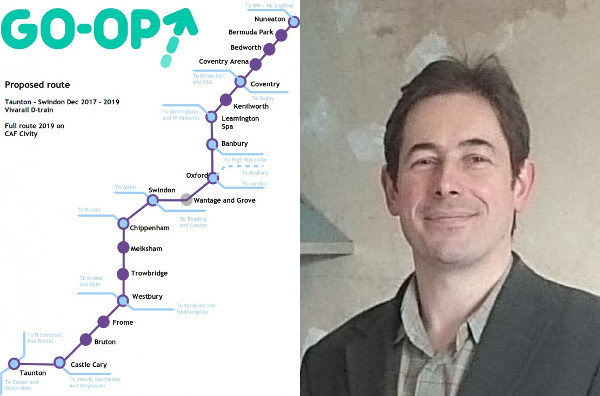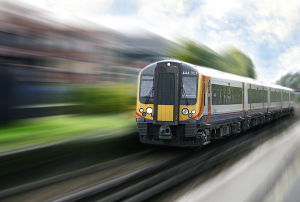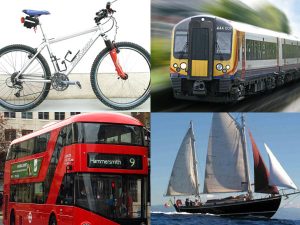Today we’re talking with Alex Lawrie. Alex does a lot of things in the co-operative sector but we want to talk to him specifically about his attempts to launch a co-operative railway line, plus lightweight community transport. Let’s start with Go-op, which is a proposed co-operative train line.
I notice you’ve got a Wikipedia page – which means it’s real, and you have to do it now! So where did the idea come from?
That’s a good question. I remember the first inklings of this was back in the 1990s when I was living in Leeds, looking at the rail network there and thinking that surely there are extra connections that could be added. Surely all these lines that radiate outwards could be complemented by radial routes that cut across. Couldn’t an innovator add these new routes? I was impressed with some friends of mine in Huddersfield Green Party, who, as a fundraising tool, had started running charter trains to the Edinburgh Festival from various stops in West Yorkshire. I was stunned to discover that a bunch of people, no different from myself (although they did have an ex-Network Rail person among their number), could simply turn up and say ‘we’d like to book a train, to run on this day, from here to here, and we’ll sell the tickets, and if we can turn a profit, we’ll make a bit of money on it.’ They ran it as a fundraiser and it was enormously successful. I was hugely impressed with that. So that planted a seed.
Then I moved to Somerset and got more involved with co-operative development. We were living in Yeovil – a large and fast-growing town, but it has an extremely unhelpful layout of train tracks, coupled with a limited service that never sticks to published times. Little changed in the 15 years I was living there, and I began to think that someone else could organise some additional rail services. I could see that you could take trains from the West Country, all the way through to the West Midlands, simply by using existing track – no need to lay any additional track. The problem with this country is that everything’s assumed about getting to London. But we don’t build our road network on that basis. Everyone accepts that the roads can help us get where we want to go without going into and back out of London. Why can’t we apply that logic to rail?
There used to be a lot of cross-country rail, didn’t there?
Certainly there were more lines and more opportunities. There was a big distinction between slow services and fast services. The express services have always favoured London. The exceptions are the cross-country network, which has always been a separate franchise in its own right, and without that there really would be nothing. The statistic that lodged in my mind was that 70% of all rail journeys begin or end in London. I’m not sure if that’s current, but it’s in that ball-park. And people always use that statistic to say that that shows that London is the only place that people really want to travel to, and if you want to make money on the rail network, you’ve got to have a route to London. I came to exactly the opposite conclusion from it – that the routes into London are saturated. That bit of the market is satisfied. It’s the other routes where there is demand that no-one is meeting. Why don’t we meet it?
I think the last piece of the jigsaw was in 2000. The great co-operative thinker Jim Brown published Co-operative Capital. This was before the big boom in community shares, when co-ops raising investment directly from social investors was still an extremely unusual thing to do. He published a very detailed study on how it could be done, what kinds of rights these non-user members could be given, and he opened up the possibility that even very capital-intensive enterprises, which had previously been thought of as something that co-ops couldn’t consider, could actually be taken on by organisations following co-operative principles. I started thinking that we could do this – we could form a co-op that ran rail services.
I was also keeping an eye on Hull Trains, who were one of the most prominent open access operators. A group of business people in Hull noticed that there were no direct services from this major northern city to London. So they organised an express service to London that ran every 2 hours. It was very successful.
When you say ‘open access’ – what do you mean?
So I have to make the distinction between open access and franchise services. Most services on the railway network since rail privatisation in 1992 have been franchises. The government has split the country into blocks. Typically they are regional franchises, so we have Great Western covering the Cornish peninsula, London Midland going up to Birmingham, there’s the Northern, Southern and South-Western franchises. When you look at a map of the rail franchises, with the exception of Scotrail, Northern and Cross-country, what you see is a group of wedges, all radiating out from London. Each franchise has one London station. GWR get Paddington for example, and they get all the trains and track that emanate out from that station, all the way out to, in GWR’s case, Penzance. That way, virtually all the existing, established routes on the railway, were allocated franchises that were auctioned, and the highest bidder got to run them. In the case of GWR, which is a highly-subsidised franchise, it went to the bidder requiring the least subsidy.
Now, the 1992 Rail Privatisation Act allowed for the possibility that new rail service providers might be interviewed outside of these franchises, simply by entrepreneurs developing their own routes, making the case for them and finding space on the timetable and starting to operate. Because the government wanted to ensure it could raise as much money as possible from the franchises, it obviously had an interest in protecting franchisees from competition, and so there were all sorts of restrictions around this – but over time the restrictions were gradually reduced. For some reason, open access rail never really took off. Even today, I think around 0.1% of all rail journeys in the UK are open access. The others are all through franchises. Over time, unease has grown in the regulator – the Office of Rail and Road, which is charged with ensuring competition on the railways – that the railways might not be a very competitive marketplace. Astonishing conclusion, I know.
So we turned up and said ‘OK, you say you want competition on the railways, we’ll put you to the test. We would like to compete please. We’ve got a perfectly sensible idea, and we’ll work out a good timetable, check that it’s feasible to start running trains. What could possibly be wrong with that? On a number of occasions, I’d been warned by people, that the railways are the third most heavily regulated sector of the economy after – I think it’s air travel and nuclear power stations. And if I’d known what I was taking on, I probably would have reconsidered.
Do you think the regulators are onside? Are they against what you’re trying to do, or would they like to help if they could?
The only way I can put it is that they are conflicted. They do, genuinely, want competition on the railways. They do, genuinely, want innovation and people bringing forward new ideas. But, at the same time, another part of their remit is to ensure that the railways are safe and reliable. The more trains that operate on the railways, the more risks there are, and the more difficult it is to stick to a regular timetable. So when you think about it, a perfectly safe railway and a perfectly reliable railway, is one in which no trains actually run at all. So there’s always this balancing act. They have to ensure safety and reliability, but at the same time, allow a little bit of openness to innovation and the complexity of new ideas.
I have to say, I’m conflicted myself. I’m lost in admiration of the safety track record of Britain’s railways. It’s exceptional how many miles people travel without getting hurt. Do I want to compromise on that? No. But at the back of my mind, I’m thinking to myself – if we put forward a proposal and it’s stymied because the safety precautions we have to take make it unfeasible or too expensive, what’s the alternative? The alternative is that people travel on the roads. I just imagine going to the ORR with a great idea for a new rail service. Firstly, we’re not going to have one or two trains every hour, we’re going to have lots of little ones. They’re not going to be driven by professional drivers – passengers can decide who can drive the train. There won’t be a timetable – they’ll just launch onto the tracks as and when. Some will go fast, some will go much slower, and they’ll just wiggle around each other as best they can. The regulator would say that that’s insanely unsafe, and yet that describes a motorway.
So if the high standards of safety make it difficult or impossible to introduce new rail services to tempt people out of their cars, then people will be exposed to the much greater risks on the road network. There’s a balance that has to be struck.
It’s an interesting point, isn’t it? If they’re really concerned about people’s safety, they really have to try to get people off the roads.
Absolutely. Risk analysis presents itself as a quasi-scientific method, but it starts with an assumption that you’ve drawn a boundary, and that you’re only concerned with risks within that boundary. But the reality is that boundaries are permeable. People move in and out of the area that you’re concerned with, and the positions you take within that boundary determine how many people drift out of it, into other areas that you haven’t considered. That has to be part of a risk analysis – i.e. what will people do if we don’t let this service go ahead.
Is it only one route that you’re looking at?
So – right from the start, I had two big ideas. Big idea number one was that Yeovil was on a little branch line, which actually did connect up some quite important lines, but there just weren’t enough trains to get people to use that branch line. The second big idea was that at Westbury, if you don’t want to go into London, there is a little back route through the town of Melksham, and at the time, Melksham had 2 trains a day. They had a little station with what they called a parliamentary service. It was so small as to be useless, but it would require an act of parliament to remove it altogether, and no-one wanted to do that, so they kept a minimum service going, that was no use to anybody. We thought we could start at Yeovil, go through Melksham, carry on to the West Midlands, and that would be a really clever route.
How did you know the demand was there?
Only because we were living in the area. We were the demand. We were standing on station platforms thinking this is ridiculous – if we don’t get this train, there isn’t another one for an hour and a half. It’s not scientific, but it was based in reality. We knew we needed a detailed analysis to quantify demand, and I began to realise that planning a rail service could be a little bit like planning the financing of a wind farm, and wind farms have been enormously successful in the co-operative field – because although you don’t know how hard the wind is going to blow on a particular day, averaged out over a year, you can make a pretty fair guess. And it’s much the same with the flow of rail passengers. Sure, you don’t know if there’s going to be a hen party turning up mob-handed tomorrow, but averaged out over a year, the pattern is pretty consistent and predictable. You can make some fairly sensible calculations – so that if we reduce the travel time on this route by this much, or increase the frequency of services by this much, we can predict with a fair degree of accuracy what the effect will be on passenger numbers, and assuming our fares are comparable with other operators, we can make an equally robust assumption about how much money we’ll generate.
So that’s what we set out to do. Our first fundraising was what you might call seed corn investment, to try to get enough money to carry out some basic feasibility studies. We did this in 2010. At this point, I have to own up to a mistake. The temptation when starting a new enterprise, is to try and do everything – to bring out every bright idea you’ve ever had and try to put it all under this one umbrella, rather than choosing the most promising idea and making sure that that works. We flirted with light rail, car clubs, bus routes – we put resources and energy into all sorts of things, and it did detract from our work on the mainline rail. In retrospect, that was a mistake. We also made the mistake of hiring a CEO too soon. Clearly, the operation was always going to need someone quite skilled, and we made the hire based on someone who had experience, not in the mainstream railway, but in an independent heritage railway. We thought that was quite a good connection to make, and they were cheaper, but they didn’t have genuine rail experience. It was a mistake. It cost us a lot, on someone who, with the best will in the world, couldn’t really take us forward at that time. So we burned up our resources too quickly, and that created all sorts of problems further down the line.
At first, we thought that we’d got a pretty clear mechanism. We went to Network Rail. We explained what we wanted to do. They said yes, there’s a process for open access operators. Here’s what you have to do, step-by-step – off you go. We thought that would be easy. But the further we got into it, the more problematic it became. What you have to do in order to get a rail service off the ground, is to have the rolling stock – the actual trains – available to you at the times you need them.
When you say available, do you have to buy trains?
No – that really would be a challenge. Although you can buy trains if you want to, that would be incredibly capital-intensive. Much more likely is that you lease trains. The rolling stock leasing organisations are all various variety of bank, really. They lease the rolling stock as assets.
So the maintenance of the trains and the carriages is nothing to do with you?
That’s right. So we have a predictable leasing payment every month. But at the time we were doing this there was a terrible shortage of rolling stock. A lot of it was 30 or 40 years old. There were never enough carriages. There was a continual increase in rail passenger numbers, and new rolling stock just hadn’t been provided fast enough to cope with it. So the first problem was – did anyone have suitable rolling stock? And we needed pretty odd rolling stock. On the one hand, we were going to be crawling through small stations on branch lines, and within a few minutes of that, we’d be hammering along the high-speed express line between Swindon and Didcot, trying to get up to 100 mph. So it wasn’t just that we couldn’t find any rolling stock, we couldn’t find our particular rolling stock. And we also wanted to be as eco as possible – so it all made life very difficult.
So problem number one was rolling stock. Problem number two was that we had to have a demand forecast that we could rely on, that investors could rely on, and that the Office of Rail and Road could see would be introducing new passengers to the network, and not just pinching passengers from other operators. And the third problem was that we had to have a timetable that had been checked against the existing network timetable, to show that there was definitely room for it on the railway. All these things had to be ready at the same time. If one element came too late, the chances are that one of the other elements would then be out of date. We had been struggling with that for the better part of a decade.
Where are you at now? When might I be able to take a co-operative train?
Let’s bring this up to date. We think we’ve solved the rolling stock problem. Porterbrook, one of the biggest leasing companies, have developed a new version of one of their old electrical units. They realised that the UK network is really ‘bitty’. Some parts are electrified, some aren’t. You want to use electric power whenever you can – not just for environmental reasons, but for performance reasons too. But large chunks of the network aren’t electrified. Porterbrook realised that if they refurbished their old 319s, gave them a new diesel power plant, but kept the electric capability, they would have trains that could go anywhere and do anything. They’re pretty fast, with plenty of seating. Hopefully we can get them reasonably full. For the time being at least, they’re available to us. We can place an order, we can have them delivered on time – that will work.
Then we have the demand forecast – it’s gone out of date. We’re going to have to replace it. We can’t do that until we have an up-to-date timetable, and that’s been held up because Network Rail is insisting on sectional run times.
Sounds almost like a Catch-22 situation.
Well what Network Rail is saying is that we have got new-ish rolling stock, operating on a route it’s never operated on before, so we need to prove exactly how fast, and I mean exactly, these trains are going to run over the different sections of our route, taking into account gradients, slowing down for stations, line speeds around various points, signalling etc. We spent 3 days talking about one bridge just outside Didcot, which is so low over the tracks that the wires come down steeply, so you have to lower the pantagraph, then raise it afterwards in order to keep the same speed, and so on.
One of the interesting things was that at the same time as we’re doing all this, GWR are trying to increase the number of trains they’re operating. The government has asked them to provide more services, so they’re increasing the number of trains between Swindon and Didcot. That’s going to use up limited capacity, and we’re not quite as fast as we ought to be, and so it will take us a bit longer to get over that section. That’s a huge problem for us. Now, one of the things that’s been bedevilling our project is that the railways often make the news, but not in a good way. There was the franchising calamity, when Virgin challenged the award of a franchise, won in court, and the government had to admit that the entire franchising process was a disaster. That stopped new franchises being issued, which drastically reduced demand for new rolling stock, and meant that the rolling stock we were after was unavailable. More recently, we’ve had all the disruption on Southern Rail – all the arguments about driver-only operation. We had the calamity last year, when the operators tried to introduce new timetables, and Network Rail simply broke under the strain. For weeks there was chaos on the railways, as trains simply failed to turn up when they were meant to, and they didn’t have enough drivers who were familiar with the new routes etc. They’re still recovering from that.
Interestingly, that’s had the effect of preventing GWR from producing its new timetable, and we’re now, possibly, a little ahead of them – which is astonishing to me.
So just to push you, when do you think we might see some co-operative trains running?
My hope is that we can operate in December 2019. That’s our target. But we have two big problems. Firstly, although we’ve now got these sectional run times prepared, I’ve just been told that before they can be submitted to the timetabling process for consultation, they have to be ‘assured’ by Network Rail, which basically means that Network Rail have to re-do the work that our consultants have done. And there has to be a wait of a month before that can happen, and during that wait, we miss a deadline. So that’s causing me to tear my hair out, because they’ve known for months that we were preparing these SRTs, and they could have been ready to assure them in time for this deadline.

But it’s not a million years away, whatever happens – it could be 2019 / 2020?
Worst-case scenario is that we’ll push it back to May 2020. But then we’d again be up against GWR, trying to get their extra services onto the grid, and once again we’d have this big tussle with capacity.
So how can people help you? What are you looking for? Investors?
That’s a difficult question. We could do with more money, so investment is an issue. But I’ve got to say – investment? Well, you should think of it as a donation. It’s that high-risk. But yes, we’d like money – we’d be able to proceed much more quickly and more reliably if we had more money. But can we say to people that it’s an investment that’s secure? No. It’s much higher risk than any other community share issue. And for that reason, although we’re happy to accept money and issue shares, people have to think of it as they would a donation.
But it’s a very exciting project to be involved with, isn’t it – to co-operativise the railways?
It is, and I’m so frustrated that if I’d known back then what I know now, I could have done a much better job. We made so many mistakes in the early stages, and lost so much time.
What’s your ambition – your best-case scenario?
Best-case scenario is that we bring forward a timetable that people see is going to make money. Although I said start operating in December 2019, we would have a timetable by then, and start running in January or February 2020. We’d have to train new drivers, and we can’t start doing that until we’ve been awarded a track access contract. So that’s the best-case scenario now. I think we’re assembling the pieces of the jigsaw. The run times report we have now was a very important step forward. The rolling stock is really good to have in the bank. But unless we can find a timetable that Network Rail are prepared to accept in terms of capacity, we’re still stymied, just as before. And that hasn’t happened yet, so there’s still work to do. And everyone in Go-op is working on this unpaid.
Sounds like really hard work. And if it works it will be a magnificent achievement. So Jeremy Corbyn has talked about re-nationalising the railways. What would that mean for a co-operative? Surely he wouldn’t nationalise a co-op?
Re-nationalisation could mean two things. It could mean taking the franchises back into direct state control, and open access is unaffected. It could mean that he thinks the government should have a monopoly on running train services. I don’t think that’s where they’re heading. We’ve looked at all the things they’ve said, and they don’t know that much about rail. That’s not a criticism – they’re not rail experts, and I don’t think most of them are aware that open access rail exists, but given that it only operates 0.1% of the services, that’s fair enough. So basically, their big idea has loads of detail still to be worked out, and until then we have no real idea how it will affect us. I’m assuming that while they’ll want to get franchises back under state control, they won’t necessarily want the state to have a complete monopoly. That would be a very big step. So my suspicion is that the Labour Party’s plans won’t particularly affect us.
They’ve said that they want to double the size of the co-operative sector, so nationalising co-ops wouldn’t make much sense, would it?
It wouldn’t, but they can only work with what exists. When you’re in government you can only really see big things, and it’s easy to accidentally squish small things because they’re just too small to notice.
I was talking to Duncan McCann at the New Economics Foundation, and he’s trying to build a platform co-operative alternative to Uber. During the crowdfunding, they raised the licence requirement from £2.5k to £2.5 million! So he had to move out of London. He talked with the regulators and they weren’t trying to crush him. They just didn’t realise he existed.
Or that anything could exist like that.
Yes. They were just trying to raise the funds for the extra admin costs that Uber caused.
It’s the biggest problem with government. They always say they want innovation, openness, they want people to be able to try new things. But they inadvertently make decisions that wipe out an entire level of the business ecosystem, which means that smaller organisations can never build their way up to the higher levels. It effectively gives a monopoly to organisations that are already through the door, and are a large size already.
We’re almost out of time Alex, but it would be good to talk to you again at some point about Lightweight Community Transport.
Yes. The interesting case study to look at there I think is Preston Tram Power. It’s not a co-op. It’s a private business, and they’re trying to introduce a tram completely independently, with no particular support from the municipal authorities. We’re trying to support them with it, and we’re hoping we can introduce an element of community participation by doing that. But it’s another example of where our country seems to be unable to make these big, collective, infrastructure decisions, and so the whole thing gets handed to the community sector by default. But the scaling-up – the capacity required to take on these things is a huge challenge. When you’ve done it once, you can do it over an over again. But to do it the first time is an absolute bugger.
Highlights
- Everyone accepts that the roads can help us get where we want to go without going into and back out of London. Why can’t we apply that logic to rail?
- With community shares, even very capital-intensive enterprises, which had previously been thought of as something that co-ops couldn’t consider, can actually be taken on by organisations following co-operative principles.
- Government always says it wants innovation, and for people to be able to try new things; but they inadvertently make decisions that wipe out an entire level of the business ecosystem, which means that smaller organisations can never build their way up to the higher levels. It effectively gives a monopoly to large corporations.








2 Comments
This sounds brilliant. Sorry I’m not a millionaire, so can’t fund you
Extraordinary account of attempting to run a railway service. But unless I have missed something, you do not refer to the all important income stream to the Treasury from a francjhise which nothing, ultimately, is allowed to upset. Why? As probablyyou know, this represents the source of most railway investment income. Hence the Government dislike of Open Access operators who are allegedly not paying their full due in Access Charges. In other words getting a cheaper deal thanthe franchised operators.